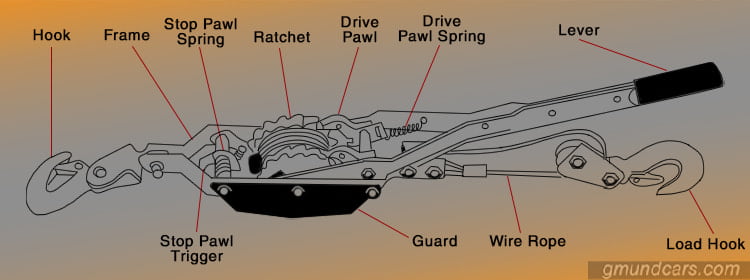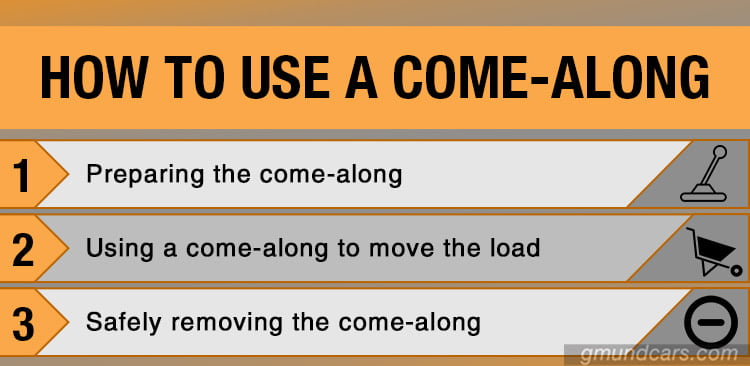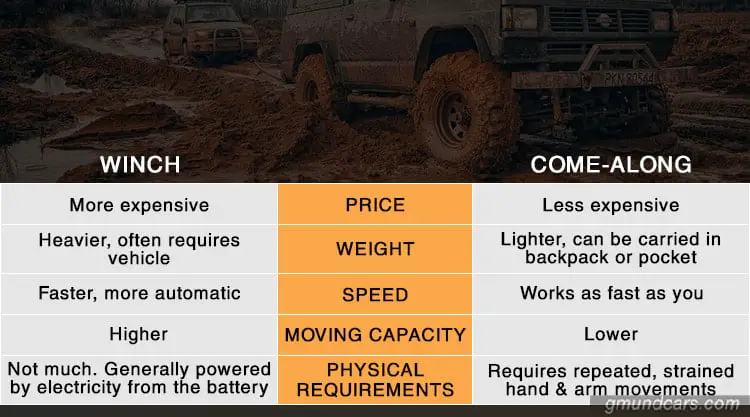The article provides instructions on utilizing a come-along for the horizontal movement of hefty items.
A come-along uses brakes, a cable, hooks, and a lever to gain a mechanical advantage. Come-alongs are easy to use and practical for most vehicle users who are stuck in a jam.
Let’s get started on discussing what makes a “come-along” and how it works.
What is a come-along?
A come-along, also known as a power puller, is a hand powered ratchet lever winch. Using simple mechanics, the strong cable and brake allow you to use leverage to pull or lift a heavy object like a car.
They are well-known for their ability to pull a stuck car a short distance to safety. Sailors also love using come-alongs as a safety tie for docked boats. Contractors find them very useful to straighten bent wood and metal sheets, as well as hoisting boards onto frames.

Safety precautions when using a come-along
The purpose of a come-along is to move or bend with a significant amount of weight. Given the amount of tension needed to fulfill its purpose, come-alongs have some safety needs.
Safety considerations
- A come-along has a designated weight limit. Do not try to bend, haul, or lift more weight than the come-along says. Know the amount of weight you are attempting to pull before deciding to use a come-along. If you need come-alongs for heavier weight objects, consider getting purpose specific come-alongs.
- Do not use a come-along to lift a load over people or objects.
- Ensure the rope or cable within the come-along is well centered in the groove.
- Wear a hard hat, safety goggles, and work gloves when using a come-along. Unexpected things happen and safety is paramount. The cable could slip and injure hands, and parts can break.
- Along with work gloves, keep hands clear of the cable pull in your come-along while it’s under load. Continue wearing gloves until the come-along anchor strap is released from the pulled object.
- Consult the manual before using a come-along on an incline. An incline increases the amount of tension and strength necessary for a safe pull.
Testing a come-along
- Test all operations before using, including retracting and pulling the extenders to ensure they work as expected.
- If lifting or moving significant weight, try the come-along on a smaller load first in a safe place. This will help test the capacity and brake while lowering risk.
- Ensure safety latches that hold items and ripe are properly secured and capable of closing. Open and close them before using.
- Read any come-along specific safety instructions that came with your particular tool.
How to use a come-along
Want to know how to setup and use a come-along? Here is a brief explanation.

Preparing the come-along
- On the come-along, release the drive pawl spring on the lever handle. The spring is within the lever handle, but isn’t the handle itself. This is smaller and needs to be up to begin. With this pulled up, you have freed the cable to connect to your intended load.
- Attach the load hook to your load. If you have two load hooks, they can be connected to form a loop.
- Take the come-along back to its anchor. This is the object you intend to tie the load to, like a vehicle or a tree.
- Squeeze the stop pawl trigger on the come-along. This is at the opposite end of the come-along from the drawn pawl. The stop pawl keeps the cable from moving further.
- Attach the anchor hook to the anchor.
Using a come-along to move the load
- You can now change the drive pawl spring from step 1 into the down position. This position enables you to begin tightening.
- You will start to need a bit of elbow grease. With the drive pawl spring down, you can begin to tighten the ratchet. Push the handle backward and forward to allow the cable to begin tightening and tensing. You should see the cable starting to move and tense up.
- The load will begin pulling as you move the handle.
Safely removing the come-along
- With actual pulling done, you can start by turning the drive pawl spring back to the up position. The cable will be able to loosen.
- Push the lever handle to the anchor hook side. This will force the stop pawl spring down. Do this repeatedly until the cable tension is released.
- You can squeeze the stop pawl trigger as the cable tension releases. You can also pull back on the unit to release tension further.
- While the load hook is still on, push the drive pawl switch back to the down position.
- Continue pulling against the come-along and load to allow the cable to retract into the drum.
Inspection and Maintenance
Your come-along does need some maintenance to keep parts in working order. Given the amount of weight it can hold, you should inspect it every time you use it.
Inspect heavier pullers more often since they hold more weight and often more risk. Read some of the basics of inspections and maintenance below.
Inspection
- Check for cracks, bending or warping in any handle metal materials. The handle should be straight and free of any cracks or signs of wear.
- Inspect the hooks for any unusual bending or cracking. Test the hooks on an object to ensure they close properly around something.
- Inspect the rope or cable more often. Look for signs of fibers or threads that are wearing. Fibers and threads should be flat and uniform with no raised pieces or tears.
- At least once per year, check all joints to ensure they are tight. Check sprockets and springs for signs of corrosion or wear.
- If a come-along hasn’t been used in over a year, grease and inspect completely as needed.
- Testing a come long in an unloaded state by releasing the cable. Ensure anchor and load hooks work. Don’t test a come-along without testing it unloaded first.
Maintenance
Regular maintenance can make your come-along last longer. Maintenance also reduces the risk of breakdowns and injuries.
- Grease or lubricate moving parts on a regular basis. Especially grease or lubricate if a part is making an excess sound or is more resistant. Use maintenance lubricant or grease as prescribed by your user manual.
- Parts might need replacing. Do not weld or modify any parts of your come-along. Rather than modifying parts, replace them with identical parts. Come-alongs are designed with small parts meant to work with a specific load amount.
- The brake on your come-along is very important. Replace it if it looks worn, has chips, or has corrosion.
- One good way of testing your brake is to try to move a smaller load first. Hook your come-along up with a 200-pound weight and see if the brake can hold it.
Can you use a come-along as a winch?
Come-alongs and winches are similar but aren’t quite the same tool.
Yes, you can use a come-along as a winch. Both a come-along and a winch serve the purpose of moving sometimes large amounts of weight. They just do it differently.
Just take a look at this comparison table between Winch and Come-along. Then you can consider carefully before deciding on which one is better for you.

Frequently Asked Questions
Can a come-along be used for lifting?
No, a come-along is not to be used for vertical lifting. A come-along is designed to pull an object across a surface. Come-alongs have the potential to lift an object, but they aren’t made for the purpose.
How to use a come-along to tighten a fence?
A come-along can be used to tighten a sagging fence.
Wrap the anchor rope around the fence post, then connect the hook back to the anchor on the come-along. Insert the fence wire into the other end of the come-along, leaving some space at the end of the wire for reattachment to the post.
With the load end secured to the fence wire, push the lever toward the post you want to attach the wire to. Continue and repeatedly pull until the wire becomes tighter.
If disconnected, wrap the wire around the post a couple of times. Use pliers to tighten the wire to itself once wrapped.
How to release a come-along?
When you are done using the come-along, it’s time to safely disconnect it from the load. First, you should release the drive pawl spring. Releasing the drive pawl spring from what is usually the left side of the handle will let the cable loosen.
The next step is to pull the lever handle back to the anchor side. You’ll want to keep pushing the lever back and forth to use the ratchet, just like when you tightened it. This process is just the opposite.
Once the cable is loosened enough, you can safely remove the straps from the load.
Ideally, you can keep the cable in a nice straight line and ratchet the entire cable right back into the come-along. You could find yourself ratcheting all the way up to the load, then neatly and easily removing the strap.
Conclusion
Now that we’ve learned more about what a come-along is and how to use it, it’s time to go try it out. A come-along can quickly become a great tool for moving big objects a short distance in a cheap and convenient way. They are a suitable option for when you are on the go and don’t want to use a full electric winch.